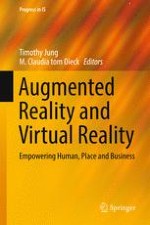2018 | Supplement | Buchkapitel
The Sensorama Revisited: Evaluating the Application of Multi-sensory Input on the Sense of Presence in 360-Degree Immersive Film in Virtual Reality
verfasst von : Sarah Jones, Steve Dawkins
Erschienen in: Augmented Reality and Virtual Reality
Aktivieren Sie unsere intelligente Suche, um passende Fachinhalte oder Patente zu finden.
Wählen Sie Textabschnitte aus um mit Künstlicher Intelligenz passenden Patente zu finden. powered by
Markieren Sie Textabschnitte, um KI-gestützt weitere passende Inhalte zu finden. powered by
